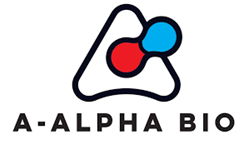SEATTLE, May 16, 2023 — A-Alpha Bio, a synthetic biology and machine learning company that measures and engineers protein-protein interactions, and Lawrence Livermore National Laboratory (LLNL) today announced a collaboration to combat multiple pathogen families of concern.
To enable this work, A-Alpha Bio has been awarded an additional $2.4 million sub-contract from the Joint Program Executive Office for Chemical, Biological, Radiological and Nuclear Defense (JPEO-CBRND) in support of the Generative Unconstrained Intelligent Drug Engineering (GUIDE) Program, which the company will use to generate large-scale and quantitative protein-protein interaction (PPI) data and support LLNL’s advanced high-performance computational models for antibody discovery and development.
In support of DOD, over the past year, A-Alpha and LLNL have measured tens of millions of protein interactions between antibodies and coronavirus variants using A-Alpha Bio’s AlphaSeq platform. The experimental data has proven valuable for building and refining LLNL’s computational models for predicting antibody sequences that bind to current and possible future variants of concern. Beyond the pandemic, there is a well-recognized need to ensure preparation for other potential biological threats. Under the GUIDE program, A-Alpha and LLNL will focus their efforts to generate antibody-antigen binding data and train predictive Machine Learning (ML) models for multiple pathogen families prioritized by the DOD.
A-Alpha Bio’s AlphaSeq platform represents the first large-scale and quantitative approach for measuring protein-protein interactions. The AlphaSeq platform can simultaneously measure millions of interactions between antibodies and antigens to determine properties like affinity, specificity, cross-reactivity, and epitope engagement. These data are particularly valuable for training and validating ML models aimed at predicting desirable antibody sequences for therapeutic development. Under the new funding, the teams will work on 5 selected pathogen families that are considered biothreats.
Antibody libraries from LLNL and others will be synthesized and cloned into the AlphaSeq platform to measure all pairwise interactions between each antibody and a library of antigen variants. LLNL will use the binding data to train and refine ML models that learn the affinity landscape across antibody and antigen sequence space. Antibodies with desirable in silico binding profile predictions will be synthesized and tested in subsequent AlphaSeq assays for validation and refinement. Highly predictive ML models will enable computational design of antibodies against never before seen pathogen variants, reducing the response time for future biothreats.
“Based on our experience working with the LLNL team and the computational resources and knowhow that they bring, we are excited to tackle multiple pathogen families beyond COVID,” said Dr. David Younger, Co-Founder and CEO of A-Alpha Bio. “This expanded scope underscores the value of large-scale and high-quality antibody-antigen binding data for training ML models and the importance of rapid experimental iteration to test and refine those models.”
LLNL’s platform integrates world-class high-performance computing and simulation, machine learning, structural bioinformatics, and multi-objective optimization to perform in silico antibody and antigen design and optimization. Critical to these computational models is antibody-antigen binding data that can be experimentally determined using AlphaSeq.
“The AlphaSeq platform can rapidly measure millions of antigen-antibody binding affinities, providing data for our high-performance computational models and enabling accurate binding predictions,” said Daniel Faissol, Principal Investigator for AI-Driven Development of Biologic Countermeasures at LLNL. “Our collaboration with the A-Alpha Bio team leverages their platform and expertise toward state-of-the-art computational models that will accelerate drug discovery.”
About A-Alpha Bio
A-Alpha Bio uses synthetic biology and machine learning to measure, discover, predict, and engineer protein-protein interactions.
The company’s AlphaSeq platform applies synthetic biology to experimentally measure millions of protein-protein interaction affinities simultaneously. Protein binding data is incorporated into the company’s AlphaBind platform to train machine learning models that predict binding from sequence. A-Alpha Bio uses both platforms to discover and optimize high-impact therapeutics for their own pipeline and in partnership with industry leaders.
A-Alpha Bio is based in Seattle and was founded in 2017 at the University of Washington’s Institute for Protein Design and Center for Synthetic Biology.




